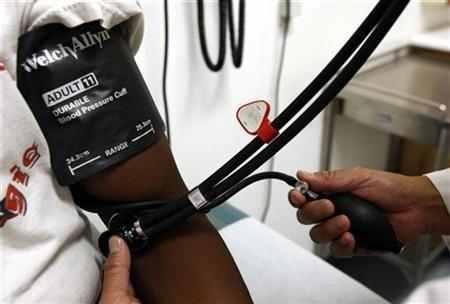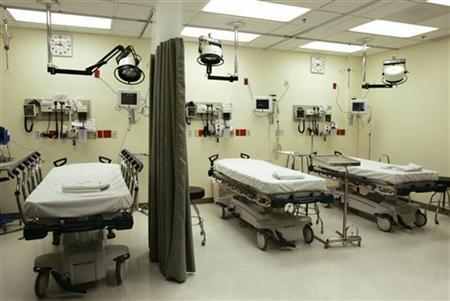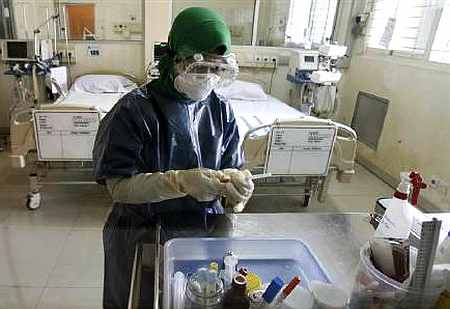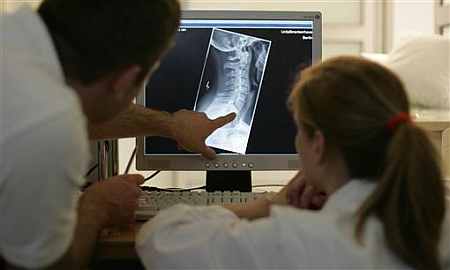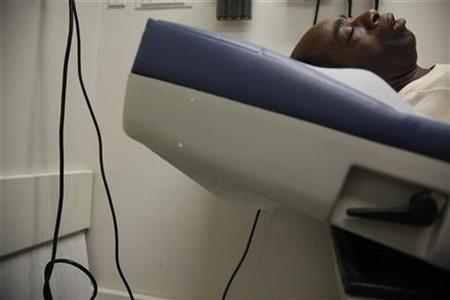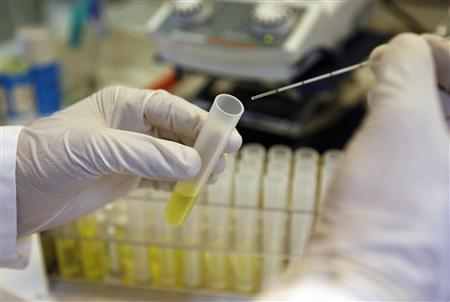 | « Back to article | Print this article |
Can India's healthcare sector paint a happy picture?
In the din of a slowing economy, falling rupee, rampaging inflation, and incessant political manoeuvrings, India's list of challenges continues to grow.
Of all these challenges, there is one that seems insurmountable already, and worse, could soon end up becoming a calamity, aggravating the suffering of hundreds of millions of Indians.
This challenge relates to the provision of affordable, accessible, and accountable healthcare to every single citizen of India.
Click NEXT to read more...
Can India's healthcare sector paint a happy picture?
On just about every single measurable indicator of healthcare infrastructure, India is rapidly deteriorating.
It is easy to mistake the gleaming glass facade of modern hospitals that have come up in the top 15-20 cities of India as a sign of India's improving healthcare infrastructure.
It is easier to get carried away by the frequent appearance of a few celebrity doctors in the newspapers and assume that the nation's healthcare is in good hands.
Unfortunately, the facts don't bear this out. Only 48 per cent of the 1.35 million beds are functional and relevant and about 65 per cent of these are located in the top 20 cities.
Click NEXT to read more...
Can India's healthcare sector paint a happy picture?
Ground reality
It is anyone's guess as to how many qualified doctors the country has. The most optimistic estimates put this number at less than 5 lakh.
More than 65 per cent of the operational beds are in the private sector, and more than 80 per cent of the spending on healthcare in India is accounted for by the private sector even though over 65 per cent of India's population is below the poverty line or living just on its fringes. No wonder that on an all-India basis, an Indian has to travel an average of 77 km to access basic secondary care services.
The above challenges are exacerbated by the fact that while the country is still struggling to bring infectious diseases under control, the incidence of non-communicable diseases is also on the rise.
Click NEXT to read more...
Can India's healthcare sector paint a happy picture?
Heart diseases, diabetes, and cancer are expected to show a combined average decadal growth of 47 per cent in future.
This will add to the demand for diagnostic, therapeutic and research facilities in tertiary care specialties.
Considering some of the anticipated trends of population and trained manpower deficits in healthcare delivery, India needs strategies that are customised to address its needs and in alignment with the financial resource available. This calls for rigorous participation from both the public and the private sectors.
Click NEXT to read more...
Can India's healthcare sector paint a happy picture?
The way forward
One such promising solution -- though one that has performed below expectation so far -- is the public private partnership (PPP) model. If implemented efficiently, it has the potential to plug many gaps in the access to basic healthcare.
PPP models should be planned and executed to leverage the expertise of private partners in infrastructure design, strong process orientation and 'safe' care delivery methods.
The training of paramedical staff and doctors on specific care protocols and patient safety practices can be devised and deployed with the support of private healthcare groups and NGOs.
Click NEXT to read more...
Can India's healthcare sector paint a happy picture?
Medical equipment firms can join hands with the government in provisioning IT-enabled point-of-care data management systems for better disease prevention and immunisation tracking.
Diagnostic services at all district/identified government hospitals can be improved by engaging private players to develop processes for effective utilisation.
Information technology is one area which, if put to optimal use, can bring immense improvements in the way we diagnose and treat medical conditions.
There are many innovative interventions in the field of mobile and electronic healthcare that have been successful in other developing markets that could be replicated in India. New concepts like doctor on web/phone are increasingly gaining ground and can go a long way in primary and secondary healthcare delivery.
Click NEXT to read more...
Can India's healthcare sector paint a happy picture?
There is also an urgent need to relook at the business models that hospitals have adopted so far. The temptation to set up world-class tertiary and quaternary multi-specialty hospitals is understandable -- and India does need them -- but then how you prioritise the allocation of the available capital is also important.
Fortunately, there are many promising initiatives in the right direction -- in setting up low cost, single specialty or even a single micro -- specialty primary and upgraded secondary care facilities, and setting up of low capital day-care centres.
Providers are waking up to the need of investing in healthcare facilities that are asset-light, low on investment and manpower requirements, and easy to scale up and replicate.
Click NEXT to read more...
Can India's healthcare sector paint a happy picture?
Corporate players which have so far concentrated mainly on achieving high occupancies in large multi-specialty hospitals are venturing into formats that involve lower in-patient hospital stay, higher bed turnover and lower operational costs.
Some of these encouraging initiatives include Narayana Hrudayalaya, Vaatsalya, Glocal Healthcare and Viva Sehat to name a few.
However, India needs a multitude of such initiatives if it were to prevent the calamitous consequences of a grossly inadequate healthcare infrastructure.
Click NEXT to read more...
Can India's healthcare sector paint a happy picture?
Role of government
The government, on its part, needs to support these efforts by providing subsidies on land, and medical equipment and tax benefits to professionals working in such organisations, especially in rural areas.
It should also take a cue from such low-cost models and consider setting up short stay medical centres at the district/identified government hospitals that would relieve the pressure on some of the key nodal hospitals and allow minor surgical procedures to be carried out on time and perhaps reduce the cost of delivering care as well.
The public sector can take a slew of other measures to strengthen primary healthcare infrastructure. Here are some pointers.
Click NEXT to read more...
Can India's healthcare sector paint a happy picture?
Pharmacies in all government hospitals should stock generics and supply chains should be re-vitalised to prevent stock-outs that force patients to buy medicines from private pharmacies.
There can be measures to integrate primary health centres with district hospitals to allow for continuity of care. Child care and women's care services should be strengthened by enhancing the availability of trained professionals at primary care clinics and district hospitals.
Nodal hospitals of the government should be identifies and equipped with strong emergency services for timely critical care. The number of medical and paramedical colleges in under-served areas should be increased.
Click NEXT to read more...
Can India's healthcare sector paint a happy picture?
Another probable solution, though mired in controversy, is bringing changes in the training of healthcare manpower and staffing patterns in hospitals. This should be directed to reduce the number of crises that require a doctor's intervention.
Hospitals can benefit from a broad range of training programmes to create workers with a wider array of skills such as physician assistants, nurse practitioners and diagnostic medical sonographers.
This will not only help tackle the issue of the shortage of trained doctors, but also free up doctors to devote their skill to more complex tasks. Interventions along these lines have been undertaken in some states like Tamil Nadu where nurses were trained by the government and the number of positions for them increased in primary health centres.
Click NEXT to read more...
Can India's healthcare sector paint a happy picture?
However, such examples are sporadic and need more vigour to be duplicated in other states.
In conclusion, as a formidable global economic power, accessible quality healthcare can be a key competitive strength for India.
It is imperative for the nation to relook at the current budget outlays, policies and the commitment to deliver on this comprehensively.
The author is president, Technopak Advisors, a management consulting firm.
